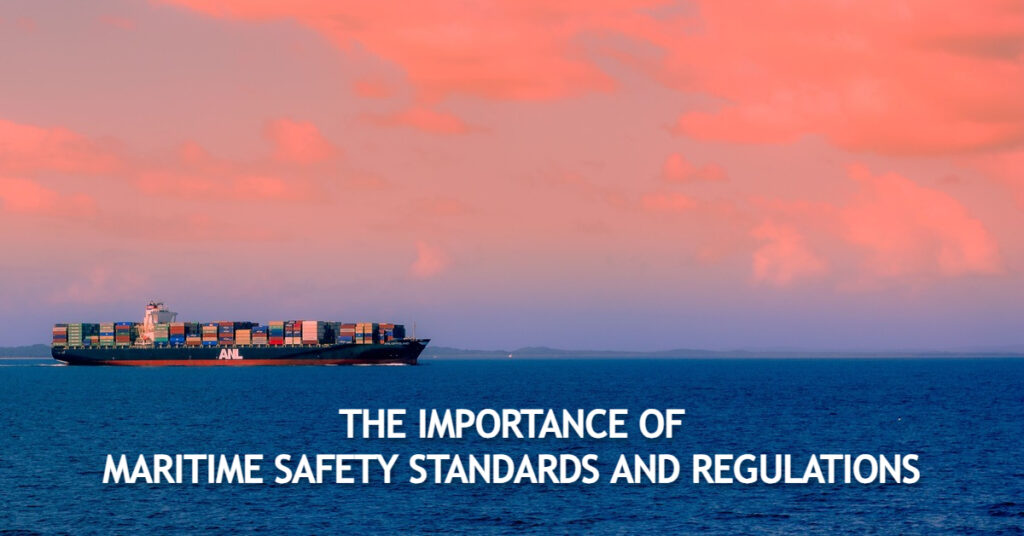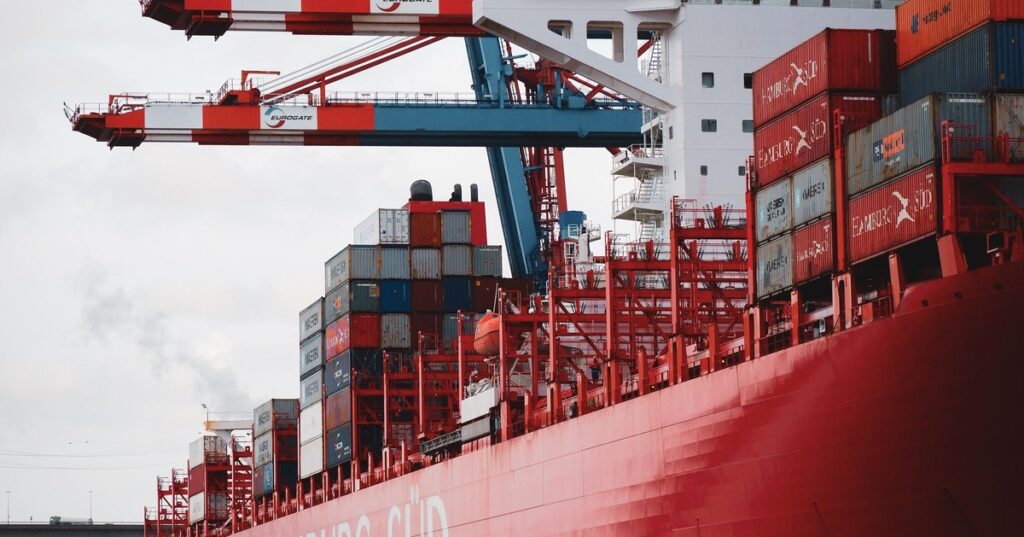Maritime safety standards and regulations are responsible for keeping international shipping peaceful, prosperous and accident-free. Many organizations work together to protect crews and passengers from the hazards associated with commercial overseas travel. In fact, deep sea shipping operations were among the first industries to widely adopt international protocols.
This in-depth article discusses the importance of maritime safety standards and breaks down the main regulations that ensure the protection of cargo ship employees.

Safety Hazards of Maritime Travel
Traversing the ocean on massive cargo ships poses many risks to maritime workers. From 2011 to 2017, there were 87 work-related fatalities among marine transportation workers in the U.S. — six times the average rate of American employees. Here are some of the main causes of this high incident rate.
Human Error
Human error is the cause of most workplace accidents, and maritime travel has many opportunities for error. Slips and falls are unsurprisingly common aboard large vessels. Heavy equipment operation is a near-constant part of the workday, creating a high risk of collisions, falls from high places and other life-threatening accidents.
Air Quality
Cargo ship employees are often exposed to toxic chemicals, including exhaust fumes, heavy metals, and solvents. That means they have a higher risk for respiratory illnesses than the average worker. Labor-intensive positions like shipyard workers, welders, and average crew members who work with heavy machinery on a daily basis are the most vulnerable.
Extreme Temperatures
Due to high humidity levels on the water, commercial vessels tend to develop uncomfortably warm temperatures. Maritime employees often experience heat sickness during long overseas journeys, especially if they work in confined spaces like the engine room. However, temperatures also drop at night, making hypothermia another big risk.
Falling Objects
The largest cargo ships have 10,000-20,000 storage units while the smallest still have more than 500. These containers shift and fall all the time during tumultuous overseas travel, posing a huge safety risk to the crew. An average of 1,566 shipping containers fall into the ocean during transport every year. Other falling objects like unsecured equipment and spilled liquids could also cause an injury.
Fires and Explosions
A fire or explosion is always a possibility on cargo ships. Heavy machinery can combust or a flammable material being transported can catch on fire. These problems are dangerous enough on land — in the middle of the ocean, they can cause the vessel to sink and lead to the deaths of the entire crew.
An Overview of Maritime Standards and Regulations
To mitigate all of the above risks, government agencies and industry professionals have worked to create international safety protocols that all shipping vessels must follow. The top governing body that enforces these protocols is the International Maritime Organization (IMO) with the help of regional, national and local institutions.
For clarity’s sake, this article separates the different standards into three categories – ship safety, worker safety and port safety. There are a handful of protocols that specifically cover each category.
Ship Safety Standards
Cargo ships greater than 300 tons and passenger ships with 12 or more people must abide by the Global Maritime Distress and Safety System (GMDSS). GMDSS standards vary depending on the vessel’s location, but there are some universal regulations. For starters, all ships must have the following safety equipment and keep it in good condition.
- 406 megahertz (MHz) Emergency Position Indicating Radio Beacon
- Very High Frequency (VHF) radio that can transmit and receive digital selective calling (DSC) and radiotelephony
- a NAVigational TEleX (NAVTEX) receiver
- a Search and Rescue Transponder (SART)
- two-way VHF portable radios
Every ship currently navigating the world’s busiest shipping routes has all of this equipment onboard and ready to use at a moment’s notice. A fast response time is essential for maritime emergencies because the closest ship or landmark might be hundreds of miles away. In recent years, about 50 major vessels have gotten lost at sea annually.
Another globally recognized code is the International Convention for the Safety of Life at Sea (SOLAS). Established in 1974, this treaty enforces the standards for ship construction, equipment and overall operations. It has undergone numerous amendments over the years, including an entire chapter of additional safety measures for bulk carriers exceeding 150 meters in length. As cargo ships get larger and more complex, so will SOLAS regulations.
Some conventions connected to IMO deal with specific operations. For example, the Convention on the International Regulations for Preventing Collisions at Sea (COLREGs) deals with basic ship navigation protocols, including actions to avoid collisions with floating debris and other ships. The International Convention on Load Lines sets the minimum for free board space according to the ship’s size, trading pattern and the season of the year.
Environmental impact is a growing concern in overseas trade. That’s where the International Convention for the Prevention of Pollution from Ships (MARPOL) comes into play. MARPOL is the main international regulatory body that prevents marine pollution in a ship’s day-to-day operations. Ships of all shapes and sizes must follow MARPOL protocols.

Worker Safety Standards
The most important regulatory body for ship crew members is the Standards of Training, Certification and Watchkeeping (STCW) Code. Adopted in 1978, this treaty lays out all of the training requirements for employees. Workers have to earn different certifications based on their positions, pass a physical exam and adhere to standard work & rest hours during their travels.
Regardless of their roles, everyone must have an International Certificate of Competence to find employment on a cargo ship. Prospective employees on yachts, fishing boats, and other smaller vessels must also earn an ICC. Anyone interested in working on the open sea in any capacity should get an ICC.
Keeping track of work conditions on a cargo ship is difficult because they spend weeks or months at sea. To solve this problem, the IMO established the Maritime Labour Convention (MLC) in 2006. The MLC requires federal governments to enact legislation that monitors maritime working hours, conditions and overall employee morale.
Maintaining employee morale is crucial for a cargo ship’s continued safety. Disengaged workers are 60% more likely to make a mistake and commit 49% more accidents than engaged workers. The IMO prevents many errors and accidents simply by keeping spirits high and ensuring every employee gets enough free time.
The IMO also requires all ships, both commercial and domestic, to follow the Life-Saving Appliances (LSA) Code. All vessels must have a specific number of life jackets, immersion suits, visual aids, thermal protective, and other safety equipment depending on their size and the number of employees on board.
As cargo ships have become more advanced, so too have safety training protocols. Employees are expected to be comfortable with distance learning and e-learning according to a 2010 revision of the STCW Code. Digital platforms like Safety Culture offer mobile training resources and allow employees to create checklists for maritime safety compliance.
Port Safety Standards
The globally recognized set of port safety standards is the International Ship and Port Facility Security (ISPS) Code. The ISPS Code primarily deals with keeping commercial vessels safe and secure while they’re still in port. The main component of this code is the Declaration of Security (DoS), a document that vessels must complete to gain entry into certain ports.
The DoS gives port managers and ship captains a chance to communicate the unique security requirements of each work environment. They can then develop an appropriate course of action that meets the standards of both parties. The DoS isn’t required for all port visits, but you will find it at almost every major shipyard in the world.
The ISPS also requires ports and the ships occupying the yard to develop a facility security plan. Training, exercises and emergency drills are fundamental parts of the security plans. ISPS officials conduct frequent security assessments of ports and vessels to ensure compliance and make necessary changes.
Finally, the ISPS designates a security officer to every port, ship and shipping company. These officers are the eyes and ears of the ISPS who enforce the code on a daily basis. They help ports and vessels address various safety and security concerns, including trespassing, thievery, terror attacks, piracy, illegal maritime trade, cyberattacks and environmental hazards.
Although instances of piracy and terrorism are globally rare, there are a handful of criminal safe havens in the Indian, Pacific and Atlantic oceans. Criminals also prefer to target large merchant vessels because of the potential for high monetary gain and because of insufficient law enforcement in international waters.
All shipping companies must also follow the International Safety Management (ISM) Code. This code’s main purpose is to ensure that companies have up-to-date operating licenses and safety management systems. Shipyards undergo regular ISM audits of important safety protocols such as emergency procedures, lines of communication and sustainability initiatives.
Another IMO-associated initiative is Port State Control (PSC), the group responsible for inspecting foreign ships in national ports. Officials inspect the ship’s condition and equipment compliance with international regulations. A PSC inspection includes an initial inspection upon arrival, an expanded inspection of minor deficiencies and a concentrated inspection campaign if the deficiencies are ongoing or significant.
Maritime Safety Keeps the World Moving
It’s impossible to overstate the importance of maritime safety standards and regulations. They allow the global economy to thrive by protecting overseas trade from internal and external threats. Without them, major international waterways would devolve into anarchy and workplace injuries would be daily occurrences. Maritime safety keeps the world moving in many ways.
Frequently Asked Questions About Marine Safety
Is working on a cargo ship dangerous?
Yes, working on a cargo ship is statistically more dangerous than other jobs. Marine transportation workers in the U.S. have a workplace fatality rate six times higher than the average American employee.
What is the main organization responsible for maritime safety?
The main organization that creates and enforces overseas safety standards is the International Maritime Organization, which is a specialized agency of the United Nations. The IMO has established many globally recognized treaties and conventions since its establishment in 1958.
How do safety standards on commercial ships differ from non-commercial ships?
Overall, commercial ships have much more stringent safety standards than non-commercial ships because they belong to a business and travel in international waters. There is some overlap between the two categories with safety equipment, emergency procedures and navigating around other ships, but shipping vessels generally have to follow many more rules.
How often do commercial ships get lost at sea?
About 50 major shipping vessels have gotten lost at sea annually in the last few years. These stories don’t make national or international headlines because 50 is a comparatively small number from previous decades. Safety protocols and supply chain visibility have greatly reduced the number of lost vessels in recent years.
How often do shipping vessels lose cargo?
In 2022, cargo ships around the world reported losing 661 containers at sea, which is well below the yearly average of 1,566. This number is small when you consider that thousands of vessels make overseas journeys multiple times a year, transporting millions of containers in the process.
- The Push to Reduce Cruise Ship Carbon Emissions in 2024 – July 19, 2024
- Marine Satellite Internet: How Ships Keep Connected – July 10, 2024
- What to Wear on a Boat – June 24, 2024




Leave a Reply